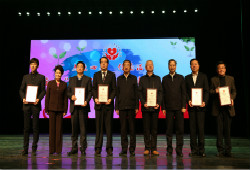
The Top IT Strategies To Bring About Business Transformation
Note: This story was contributed by Vikas Bhandari, Chief Information Officer of Hanas Group, and was featured in September 2017 in the thought leadership column of “CEO Insights” at Consultants Review, a Bangalore based portal website and magazine presenting thoughts, trends and developments for business leaders in the Asia Pacific region.
Bhandari introduced Hanas Group’s IT strategy – building its own Private Cloud platform to guarantee data security while taking advantage of technology convenience and disclosed its future scenario of connecting its Private and subscription based Public clouds into a hybrid solution to be able to scale and respond to web scale demand from consumer facing applications.
In near future, Hanas Group IT will operate as a Center of Excellence where apart from being responsible for centralized infrastructure services, will provide support and guidance to the BUs on acquisition of applications, systems and services from the market, provide program and vendor management services, provide governance for the overall technology landscape and manage overall risk.
September 2017, Source: www.consultantsreview.com “CEO insights” column
By Vikas Bhandari, CIO, Hanas Group
Today, we are seeing large-scale adoptions of 3 key technologies/strategies by organizations in support of business goals. These being Cloud (whether Private, Public or Hybrid), Bimodal or 2 speed IT and Software as a Service (generally a hosted solution sold as ‘cloud’ solution to business and addressing a specific process/function).
In the industry, we have seen very quick adoption of Cloud technologies, generally with companies utilizing Amazon’s AWS and Microsoft Azure for easy and scalable access to infrastructure globally. However, there are still challenges with adopting purely a Public Cloud solution, specially given that data centers for cloud services are generally hosted out of a few countries in the region (Singapore, HK, Japan and Australia) and countries are enacting legislation with regards to data privacy and data residency (to name just a couple of issues). Moreover, enterprises (such as ourselves) do not feel entirely comfortable putting all of our operational data on public infrastructure. At Hanas New Energy Group, we are actively building our own Private Cloud platform as well in country allowing us to rollout scalable and on-demand infrastructure solutions to our business units while maintaining full control over the physical infrastructure. In future, we might consider connecting our Private and subscription based Public clouds into a hybrid solution to be able to scale and respond to web scale demand from consumer facing applications.
Bimodal or 2 speed IT is also something that is increasingly being adopted, specially as newer technologies are adopted and businesses and users are demanding much faster response times. Traditional IT is being split into Support and Operations teams that are focused on keeping the lights on, while newer more agile, multifunctional teams are delivering new capabilities and applications using agile methodologies working closely with both businesses and vendors.
Finally, we are seeing increasing consumption by business units and functions of Software as a Service (SaaS) solutions, businesses and functions are much more open to subscription based services that provides a specific solution/function – whether a complex offering such as Success Factors or Work Day or something simpler like project/team management using Trelloor Basecamp. Businesses and Functions are able to go out and source applications/solutions directly from the market with/without the support of the corporate IT function.
Change cannot be taken for Granted; it needs to be Revisited Constantly
A lot of CIO’s are responsible for transformation (and innovation) and the challenge for us IT professionals is to not only understand the technological changes but also a very good understanding of the business and the impact these changes can have on our businesses.
The challenge to transformation at large complex organizations is the inertia of status quo or even sometimes a lack of understanding/appreciation of how quickly the world around us is changing. At the same time, enterprises that were once unassailable in their industry/vertical by virtue of their cornerstone or monopoly/utility status are now being challenged by upstarts with entirely new business models.
I have found that in situations where there is complacency and/or resistance to change, extensive and on going communications combined with education is probably the only way forward. A good starting point to educating and one of my favorites is the article ‘Why Software is Eating the World‘ by Marc Andreessen. At the same time, CIO’s need to be able to talk about business impact rather than technological change, to be able to get their message across.
In capital intensive and heavy industries, such as the verticals in which Hanas operates (Energy/Oil & Gas) the challenge is not so much from upstarts but a transformation in how we utilize technology to better respond to market forces and of course in responding to the ever evolving demands of our customer base which having grown used to an on-demand world expects the same from us.
Encountering Challenging Projects at Hanas
My role within Hanas has been challenging and extremely rewarding as well. I was lucky to have joined the organization when Hanas was ready to move to its next phase of evolution and I was charged with defining our Group IT strategy just as the market shift to cloud and agile technologies was becoming mainstream. As part of our transformation, the strategy that I put in place was based on the below main themes:
– Leverage external competencies for utility computing,
– Build next generation scalable infrastructure to support operational/sensitive applications, and,
– Build a CoE (Center of Excellence) for IT
- Leverage Public cloud and services as much as possible, We at Hanas were an early adopter of Office365 and Azure, and migrated all of our utility computing needs to Office365 and Microsoft Azure during 2013/2014. After all, who better to manage and support exchange, SharePoint, AD and basic computing than the company that develops all of these systems in the first place.
- As the next stage of evolution, per our strategy, we are now building our own Private Cloud platform, where most of our operational systems will be migrated to, over time, allowing us to standardize and centralize the provision of infrastructure services within Group IT, while enabling the Business Unit IT teams to focus on BU specific operations/support (current) and future technology, instead of infrastructure.
- Our next phase, will see Group IT operating as a Center of Excellence where apart from being responsible for centralized infrastructure services Group IT provides support and guidance to the Business Units on acquisition of applications/systems/services from the market (SaaS), provides program and vendor management services, provides governance for the overall technology landscape and manages overall risk.




